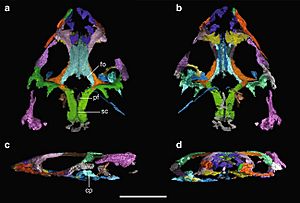Colobops facts for kids
Quick facts for kids Colobops |
|
|---|---|
 |
|
| A 3D reconstruction of the skull of Colobops | |
| Scientific classification | |
| Genus: |
Colobops
|
| Species: |
noviportensis
|
Colobops is a fascinating type of reptile that lived a very long time ago. Scientists officially named this creature in 2018. Its fossils were found in Connecticut, a state in the United States. Colobops lived during the Late Triassic period, which was a time when many new kinds of reptiles and early dinosaurs were appearing on Earth.
Contents
What is Colobops?
Colobops is a genus of ancient reptile. This means it's a group of closely related species. So far, only one species, Colobops noviportensis, has been discovered. Scientists found its fossils, mainly parts of its skull, which helped them understand what this small reptile might have looked like.
When did Colobops live?
Colobops lived during the Triassic period, specifically in a part of the Late Triassic called the Norian age. This was about 214 to 210 million years ago! To give you an idea, this was long before the giant dinosaurs like Tyrannosaurus rex or Triceratops roamed the Earth. The Triassic period was a time of big changes, with new plants and animals evolving.
What did Colobops look like?
From the skull fossils, scientists think Colobops was a small reptile. Its skull was quite unique, suggesting it might have had a powerful bite for its size. The 3D reconstruction of its skull helps us imagine what its head might have looked like when it was alive. It probably had a short, deep snout.
What kind of reptile was Colobops?
Scientists are still debating exactly where Colobops fits in the reptile family tree. Some think it might be a type of rhynchosaur. Rhynchosaurs were plant-eating reptiles with beaky snouts that lived during the Triassic period. If Colobops was a rhynchosaur, it would be related to creatures like Mesosuchus.
Other scientists believe Colobops might be a very early member of the rhynchocephalian group. This group includes the modern-day tuatara, which lives in New Zealand. If Colobops was a rhynchocephalian, it would be related to ancient reptiles like Brachyrhinodon. This debate shows how exciting and challenging paleontology can be, as new discoveries help us piece together the ancient world.
Images for kids



